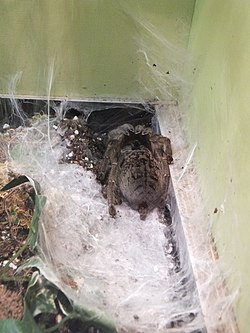Biology:Ceratogyrus marshalli
| Ceratogyrus marshalli | |
|---|---|

| |
| Scientific classification | |
| Domain: | Eukaryota |
| Kingdom: | Animalia |
| Phylum: | Arthropoda |
| Subphylum: | Chelicerata |
| Class: | Arachnida |
| Order: | Araneae |
| Infraorder: | Mygalomorphae |
| Family: | Theraphosidae |
| Genus: | Ceratogyrus |
| Species: | C. marshalli
|
| Binomial name | |
| Ceratogyrus marshalli (Pocock, 1897)
| |
| Synonyms | |
| |
Ceratogyrus marshalli, also known as Straight Horned Baboon or Great Horned Baboon Tarantula, is a species of tarantula from the genus Ceratogyrus. It is found in Zimbabwe and Mozambique.[1] It was first described by Reginald Innes Pocock in 1897, as half of the Ceratogyrus genus, they own a impressive horn in the carapace.
Description
Females live from 8 to 10 years, while males only live 3 to 4.[2] With a body length of 6 cm and a 15 cm legspan it is a fairly large species of Ceratogyrus.[3] Their carapace is black with some light brown striping, of course their being their namesake straight black horn. Their opisthosoma is light brown, covered in black spotting, although sometimes a fishbone pattern is apparent. Their legs are a light brown, or grey depending on visible conditions.
Habitat
They can be found in Harare, Zimbabwe, where this section will be referring to. This area is considered to have a subtropical highland climate. The average temperature here is 19°C, with average yearly rainfall of 805mm, since it is found 1500m above sea level, it has a surprisingly stable temperatures.[4][5][2]
Behavior
They are a very defensive spider, as most tarantulas it will first try to flee, if unable it will result in stridulation or a bite. They are burrowing and will make a vertical tunnel leading to a burrow in the end. At daytime they will most likely be in said burrow, and at night she will stay vigilant at the edge of her tunnel.[2]
See also
References
- ↑ "World spider catalog". https://wsc.nmbe.ch/species/37281/Ceratogyrus_marshalli.
- ↑ 2.0 2.1 2.2 "Ceratogyrus marshalli" (in en-US). 2016-01-03. https://www.theraphosidae.be/en/ceratogyrus-marshalli/.
- ↑ "Theraphosidae Ceratogyrus". http://www.theraphosidae.be/en/ceratogyrus-marshalli/.
- ↑ WMO. "World Weather Information Service" (in EN). https://worldweather.wmo.int/en/city.html?cityId=263.
- ↑ ""Klimatafel von Harare-Kutsaga (Salisbury) / Simbabwe" Baseline climate means from stations all over the world". https://www.dwd.de/DWD/klima/beratung/ak/ak_677750_kt.pdf.
Wikidata ☰ Q956828 entry
 |

